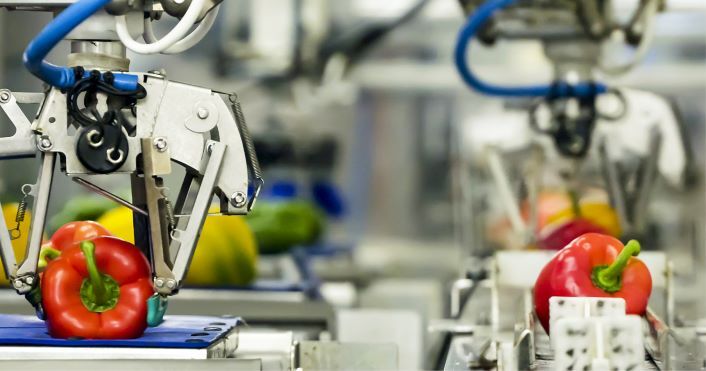One guaranteed topic of conversation is the skills shortage in the food and beverage industry (F&B,) especially in a post-Brexit and post-Covid world. Workers want more pay, more flexibility, and a career they are more passionate about.
Here, Garry Lewis, Market Development Manager for FMCG looks at the bigger picture of today’s workplace dynamics and shows how a blended working approach, using a combination of automation and zero touch solutions, together with a human workforce can work together to benefit the industry and its end users.
It’s fair to say the skills shortage facing the industry is at critical level, with a talent gap across a range of professions. The biggest concern is a divided workforce, where each group contributes to the industry success with differing, apparently opposing, skill sets.
In the food manufacturing industry, this divided workforce poses a significant challenge to testing timeliness. Latest figures show a ‘chronic shortage’ of labour when it comes to lower skilled roles, with around 290,000 full-time workers having left the sector since the start of the pandemic, 67% of companies now facing shortages in seasonal labour and 72% in unskilled roles such as pickers and packers. Fewer people can, in theory, result in delays in the manufacturing process, delays in getting product out the door, and increased cost for storage.
In practice, the way forward is to establish a balanced medium between a human workforce and new ways to automate manual processes with zero touch solutions. This will help and protect employees, optimise processes and improve product quality.
Improving working conditions
As a company’s most valuable assets, employees must reap the benefits of any implementation of technology. It’s important to devise strategies for deploying or retraining them to carry out more value-adding tasks.
The numerous manual tasks in the production environment create an enormous cost burden for manufacturers as they tie up valuable staff resources, impede efficiency, hygiene and safety compliance and introduce unnecessary risks. Many routine tasks can rapidly become boring or frustrating, it becomes clear that manufacturers key assets are not being used to their full potential.
But which processes should be automated to improve efficiency, safety and sustainability?
Examples of repetitive manual tasks include sorting and classifying goods; and aligning, orienting, filling and labelling containers. Others include lifting and handling boxes and cartons; replenishment; moving finished goods; and quality inspection and warehousing. As employees interact with machines and stand for many hours, there’s an increased risk of postural harm or accidents – which can also reduce productivity.
Automating repetitive processes
Repetitive processes must also become more efficient. Robotics and automation solutions can help by transporting, sorting or palletising loads, both in mass and customised production. For example, fully automated solutions can be used in high-speed lines.
These include industrial robotics, high-speed pick-and-place applications, smart conveyor belts, integrated machine robot control, and data analysis at machine level (AI).
In customer-specific environments, Autonomous mobile robots (AMRs) provide flexibility, as they can adapt to change faster and better than permanently mounted industrial robots. They can transport goods and raw materials extremely efficiently, considerably reducing the working days a year which are lost through injuries to employees moving around the factory or warehouse.
Furthermore, AMRs transport products rapidly, and dispose of waste or move finished packages. AMR fleets and mobile manipulators (cobots plus mobile robots) also support quality control, traceability, order management, fulfilment and warehousing.
Zero touch strategies help to make companies more competitive and future-proof, reducing recalls and protecting their brands.
For example, a major challenge today is to provide consumers with safe, sustainably sourced and healthy food. Product quality and safety must meet increasingly strict regulations. Meanwhile, consumers are demanding product, supplier and supply chain transparency.
Traceability in food manufacturing is one such solution that can provide the peace of mind to both manufacturers and consumers. One of the main things mandated by food and beverage regulation is traceability, the practice of maintaining thorough records on the origins and whereabouts of products and raw materials by scanning printed barcodes, direct part marks (DPMs) or radio frequency identification (RFID) tags throughout the production process and the supply chain. From raw materials supplier to production line to supermarket to customer, the creation and distribution of a particular food item should be as transparent as possible.
Food and beverage manufacturers also benefit directly from traceability protocols that minimize the occurrence and effect of costly issues such as product recalls by providing real-time data on supplier materials, processes and machinery involved in production. These protocols can significantly reduce cost of a recall by isolating tainted items and making it unnecessary to pull large amounts of non-tainted product off the shelves.
Improving Quality
The more often employees touch a product during manufacturing, packaging or labelling, the more likely it is that recalls or returns will occur. Damaged packaging or non-compliant labels are also areas where improvements could be made.
To avoid contamination and soiling, goods and raw materials could be sorted or transported mechanically rather than manually.
Labelling and quality control can be handled by automated systems, cameras and robotics to minimise human contact. Innovative camera solutions can also detect contaminants on products or in containers much more accurately than employees. High-performance inspection systems provide support; and a single controller can take over various tasks at different locations and times, which isn’t possible for employees.
Another risk is biological contamination. Robotics can eliminate direct contact with the product. In mass production lines, this can be achieved with high-speed industrial robots, integrated automation systems and high-performance inspection systems. In specialised lines, cobots equipped with smart cameras ensure hygienically clean pick-and-place processes.
The smart camera technology combines quality control, code and digit reading in a single step. AI-supported automated and scalable quality control ensures increased accuracy, as errors are no longer overlooked.
In summary, for the food and beverage industry, a committed workforce is absolutely integral. Being able to work seamlessly, quickly and efficiently is vital to success.
To overcome the skills shortage in a post-Brexit, post-Covid age, it’s not just about looking within, but also thinking differently, understanding the bigger picture and starting to embrace the opportunities of working with new technologies and zero touch solutions.
This can help to improve the quality and freshness of food and reduce waste in the food production process. Similarly, AI and ML will help a zero touch approach to deliver a smarter and more sustainable use of resources whilst also helping to optimise products and brand image.
Here lies the potential for a fresher industry wide working environment, with employees and technologies blending to offer the necessary ability to achieve the requirements of today’s increasingly discerning customers.



